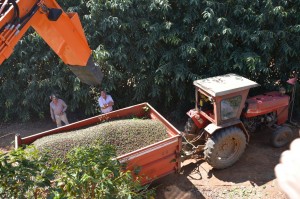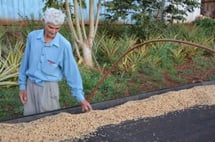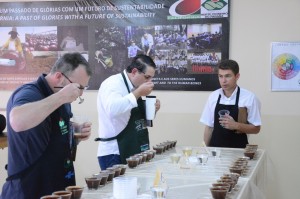The coffee market in 2014 has been rocked by volatility, soaring and plummeting seemingly at random. Among the core causes for that unpredictability has been Brazil: The world’s largest coffee producer (responsible for a third of the global supply) has been experiencing its worst drought in decades, and fears of its production losses have caused the market to soar.
 Earlier this month I traveled to Brazil to meet with several producer organizations in the Sustainable Harvest® supply chain, as well as exporters and other coffee experts. I covered more than 1,200 miles and visited four coffee-growing regions: Minas Gerais, Paraná, Espírito Santo, and São Paulo. From those travels I came away with a breadth of essential information that will help roasters, growers, and others in the supply chain be up-to-date with the situation.
Earlier this month I traveled to Brazil to meet with several producer organizations in the Sustainable Harvest® supply chain, as well as exporters and other coffee experts. I covered more than 1,200 miles and visited four coffee-growing regions: Minas Gerais, Paraná, Espírito Santo, and São Paulo. From those travels I came away with a breadth of essential information that will help roasters, growers, and others in the supply chain be up-to-date with the situation.
Here are some of the key points:
The drought has impacted quality and yield. The lack of rain for Brazilian trees has resulted in a high number of under-developed beans that are considered of inferior quality and cannot be traded on the international market. In some cases, the under-development has manifested itself in the form of floaters, or low-density beans that float in water. In other cases, farmers told us that cherries went from green and unripe to black and overripe overnight, skipping the maturation period.
Without a doubt, the weather is going to lower Brazil’s output for 2014: The harvest is still under way (during our visit sources told us it’s more than 70% finished), but the current estimates are that the drought will cost Brazil between 8 and 11 million 60-kilogram bags. On the farm level, producers in Minas Gerais and Paraná told us they’re seeing a decrease of about 20% in this harvest compared to last year’s.
 Cost of production is also impacted. Normally in Brazil, about 480 to 550 liters of coffee cherries will produce one exportable 60-kilogram bag of green coffee. But because the drought has resulted in smaller cherries, producers told us they now need 700 to 800 liters of cherries to produce the same amount of exportable green coffee. Another side of that story is that coffee pickers who are paid by volume have to pick more coffee cherries to produce the exportable bag, increasing the cost of production.
Cost of production is also impacted. Normally in Brazil, about 480 to 550 liters of coffee cherries will produce one exportable 60-kilogram bag of green coffee. But because the drought has resulted in smaller cherries, producers told us they now need 700 to 800 liters of cherries to produce the same amount of exportable green coffee. Another side of that story is that coffee pickers who are paid by volume have to pick more coffee cherries to produce the exportable bag, increasing the cost of production.
There is more volatility ahead. While we know Brazil’s current harvest will be significantly down from last year, we don’t know exactly how low the numbers will be. Adding further uncertainty to the equation is that we also don’t know what impact the drought will have on the Brazilian coffee harvests of 2015, 2016, and beyond. This uncertainty breeds volatility on the C market, so stakeholders have many months (and possibly years) of unpredictability ahead of them.
What can roasters do about it? First and foremost, roasters should be reading up on the ever-changing market, as well as the news out of Brazil. And they shouldn’t believe everything they read—there are a lot of conflicting reports of varying quality out there, so make sure to find a quality information source for market information.
 More than anything though, roasters should protect themselves against the volatility of the market. Roasters working within the Sustainable Harvest® supply chain should set a procurement plan with us that includes price insurance mechanisms, which are risk-management tools that assure that both roaster and grower are protected in the case of market volatility.
More than anything though, roasters should protect themselves against the volatility of the market. Roasters working within the Sustainable Harvest® supply chain should set a procurement plan with us that includes price insurance mechanisms, which are risk-management tools that assure that both roaster and grower are protected in the case of market volatility.
The drought has presented the coffee industry with a unique challenge, but by drawing on our strong relationships with our partners in Brazil, we’re confident that Sustainable Harvest® and all stakeholders in the supply chain will be able to thrive despite this volatile market.



.png)
